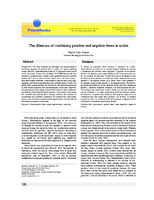The dilemma of combining positive and negative items in scales
Abstract
Background: This study analyzed the advantages and disadvantages of
combining negative and positive items in scales in a Spanish-speaking
context. Method: Three telephone surveys of 233 people each were carried
out. In one survey, 15 items from the Keyes Social Well-Being Scale were
worded in a positive fashion; another survey presented 8 items in a positive
fashion and 7 items in terms of direct denial; and in the third survey, 7
items were worded positively, 5 were worded in negative terms using polar
opposites, and 3 terms were presented in terms of direct denial. Results: The
results show a greater tendency for the items in the Positive questionnaire
to show results associated with the directionality of the items. However,
this questionnaire shows higher values of the Cronbach’s alpha coeffi cient,
and better fi t of the theoretical factor structure. Conclusions: In the survey
that included only positive items, fi ndings indicated the existence of
acquiescence bias. However, a remedy to this situation only made matters
worse, as the combination of positive an
Source
Salazar, M. S. (2015). The dilemma of combining positive and negative items in scales. Psicothema, 27(2), 192-200.Share
Metrics
Collections
- Artículos [9]
The following license files are associated with this item:



